
SS Conte di Savoia was an Italian ocean liner built in 1932 at the Cantieri Riuniti dell'Adriatico, Trieste.
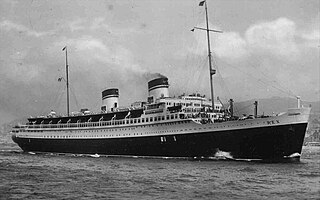
SS Rex was an Italian ocean liner launched in 1931. She held the westbound Blue Riband between 1933 and 1935. Originally built for the Navigazione Generale Italiana (NGI) as SS Guglielmo Marconi, its state-ordered merger with the Lloyd Sabaudo line meant that the ship sailed for the newly created Italia Flotta Riunite.
Italian Line and from 1992 Italia Line, whose official name was Italia di Navigazione S.p.A., was a passenger shipping line that operated regular transatlantic services between Italy and the United States, and Italy and South America. During the late 1960s the company turned to running cruises, and from 1981 it became a global freight operator.

Lloyd Triestino was a major shipping company, created in 1919 when the city of Trieste became part of Italy in the settlement after the First World War. It ran passenger services on ocean liners around the world. Seriously harmed by Second World War, in which it lost 68 ships, it recovered to run passenger services with new ships on routes as far as Australia. In 2006, with the business by then mainly container freight, the company's name was changed to Italia Marittima.
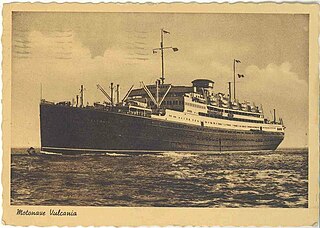
The MS Vulcania was an Italian ocean liner built by Cantiere Navale Triestino, Monfalcone, northern Italy, in 1926 for the Italian company, Cosulich Line.

SS Conte Rosso was an Italian transatlantic ocean liner that was built in Scotland in 1921–22. The vessel became a troop ship in the 1930s and was sunk by the submarine HMS Upholder in 1941.
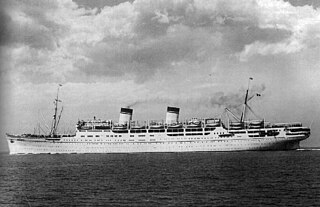
SS Conte Grande was a Lloyd Sabaudo ocean liner built in 1927 by Stabilimento Tecnico Triestino in Trieste, Italy, to service the transatlantic passenger line between Genoa, Italy, and New York City. Launched on 29 June 1927, her maiden voyage was from Genoa to Naples to New York City, which occurred on 13 April 1928. In 1932, after acquisition by the Italian Line, she was transferred to the South America service but was laid up in Santos, Brazil in 1940.

SS Conte Biancamano was an Italian ocean liner launched in 1925. The name was chosen in honor of Humbert I Biancamano, founder of the Savoy dynasty. She was built in the Scottish shipyard William Beardmore & Co. in Dalmuir, near Glasgow. She was built for the Genovese shipping company Lloyd Sabaudo, operator of Conte Rosso and Conte Verde. The engine, equipped with two steam turbines double reduction unit and two propellers, allowed her to reach a speed of 20 knots, and vented in two funnels. She housed 180 passengers in first class, 220 in second class, 390 in economic class and 2,660 in third class.

Conte Verde was an Italian ocean liner active in the early 20th century.

The SS König Albert was a German Barbarossa class ocean liner owned by the Norddeutscher Lloyd Line. Interned in Italy at the outbreak of World War I, she was seized by the Italian Government in 1915 and converted to a hospital ship. Sold into merchant service in 1920, she was used as a transport for the Italian Navy, before being scrapped in 1926.
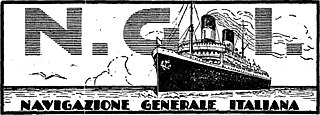
Navigazione Generale Italiana (NGI) was an Italian shipping company.
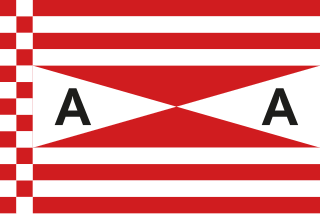
The Cosulich Line, formally the Cosulich Società Triestina di Navigazione, is a steamship line that was based in Trieste, Italy. The company had been founded in 1889 by Antonio F. Cosulich's son as a family business. In 1903 as Unione Austriaca di Navigazione, more commonly called the Austro-American or Austro-Americana Line, when Trieste was under the rule of Austria-Hungary. After the first World War, the company became an Italian-based shipping company. In 1932 the company was forced to merge with the Lloyd Sabaudo and the Navigazione Generale Italiana, to form the Italian Line.
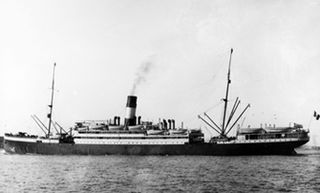
SS Taormina was a transatlantic ocean liner that was launched in Scotland in 1907 for an Italian shipping line. She was owned successively by Italia Società di Navigazione a Vapore, Lloyd Italiano and Navigazione Generale Italiana (NGI). Taormina was briefly chartered as a troop ship for the US Armed Forces in 1918. She was scrapped in 1929.
MS Augustus was a combined ocean liner and cruise ship built in 1926 for the Navigazione Generale Italiana (NGI). Augustus operated mostly on the Europe to South and North America routes, on the former being one of, if not the largest and fastest liner to sail on regular crossings.
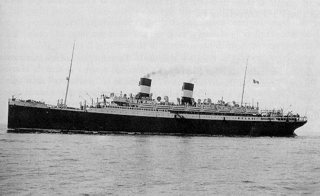
SS Roma was an ocean liner built for the Italian shipping company Navigazione Generale Italiana of Genoa by Ansaldo shipyard in Sestri Ponente. She was the sister ship to MS Augustus. The ship was later transferred to the new Italian Line after the merger of Navigazione Generale Italiana. When Second World War broke out, she was acquired by the Navy for Conversion to aircraft carrier name Aquila. She was taken over by the National Republican Navy of the Italian Social Republic and German occupation forces in 1943, but was partially sunk in 1945 by a commando attack of Mariassalto, an Italian royalist assault unit of the Co-Belligerent Navy of the Kingdom of Italy, made up by members of the former Decima Flottiglia MAS. Roma was raised and scrapped by 1952.

Sparviero was an Italian aircraft carrier designed and built during World War II of the Regia Marina. She was originally the ocean liner MS Augustus built in 1926 for Navigazione Generale Italiana, but was transferred to the new Italian Line after the merger of Navigazione Generale Italiana with the Lloyd Sabaudo and the Cosulich Line. The conversion was started in 1942 originally under the name Falco but was never completed, and the ship was never delivered to the Regia Marina. She began to be scrapped in 1947, a process completed by 1951.

SS Duilio was the first Italian super ocean liner and one of the largest Italian merchant ships until 1925. She measured 24,281 gross register tons and was the sister of the SS Giulio Cesare, which was launched in 1921. She was constructed for the Italian shipping company “Navigazione Generale Italiana” based in Genoa and constructed by Ansaldo Shipyard owned by Sestri Ponente. She was sunk on 10 July 1944.

Österreichischer Lloyd was the largest Austro-Hungarian shipping company. It was founded in 1833. It was based at Trieste in the Austrian Littoral, the main port of the Cisleithanian (Austrian) half of the Dual Monarchy.
SS Verona was a transatlantic ocean liner that was built in Ireland in 1908 for an Italian shipping line. She was a troop ship in the Italo-Turkish War of 1911–12 and in the First World War in 1917–18. In 1918 a German submarine sank her in the Mediterranean with great loss of life.

MS Orazio was an Italian ocean liner of the interwar period, owned by Navigazione Generale Italiana and later the Italian Line. She was destroyed by a fire off Toulon in January 1940, with the loss of 108 lives; in terms of loss of life this is the fourth worst peacetime maritime disaster in Italian history, after those of Principessa Mafalda, Sirio, and Moby Prince. It was however quickly forgotten due to Italy entering World War II a few months later.
























